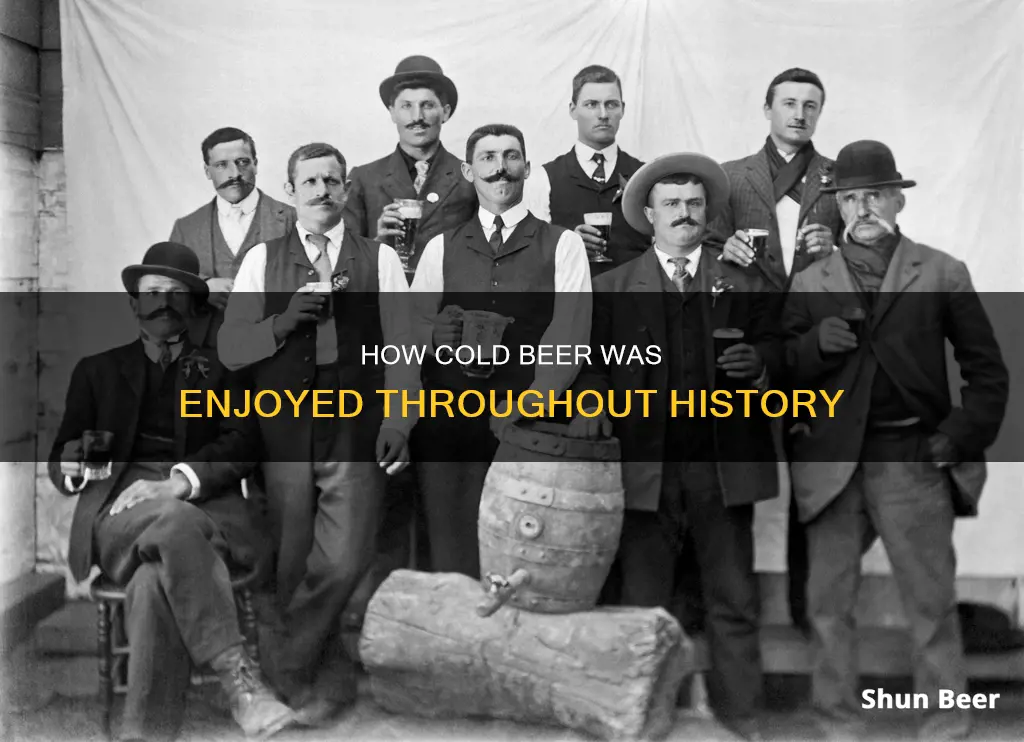
Beer is one of the world's oldest and most widely consumed alcoholic drinks, but the ability to serve and store it cold is a relatively modern phenomenon. In the past, beer was typically served at room temperature or, for several centuries, heated and spiced, a style known as mulled beer. The preference for cold beer emerged with the advent of refrigeration in the late 19th and early 20th centuries, which also enabled the production of lager beers, which require colder fermentation temperatures.
| Characteristics | Values |
|---|---|
| Beer drinking temperature in the past | From 1500 to the early 1800s, beer was typically drunk warm or heated ("mulled"). |
| Beer drinking temperature today | Beer is now typically served cold. |
| Beer drinking temperature in the past vs. today | Beer drinking temperature has changed over time, with preferences for warm or cold beer fluctuating. |
| Factors influencing beer drinking temperature | Climate, cultural norms, and the availability of refrigeration technology. |
| Historical examples of cold beer consumption | In the first century CE, the Roman emperor Nero was known for enjoying iced drinks. |
| Historical examples of warm beer consumption | From 1500 to the early 1800s, "mulled" beer was popular in Europe and colonial America. |
| Reasons for drinking warm beer in the past | People believed that drinking cold beer would upset digestion and vaporous humors. They also believed that drinking heated beer was healthier and more nourishing. |
| Refrigeration technology | Refrigeration technology has evolved from ancient ice pits and ice houses to modern mechanical refrigeration and ice machines. |
| Impact of refrigeration on beer consumption | The advent of artificial refrigeration and the development of lager beer led to a preference for cold beer over heated ales. |
What You'll Learn
- Beer was once served hot, or 'mulled', and was believed to be good for health
- Refrigeration was initially a luxury, with ice pits and ice houses being used to store food and drinks
- Wealthy Romans enjoyed glacial ice brought from mountains and stored in insulated cellars
- The advent of refrigeration in the 19th century made cold lager beers accessible to the masses
- Beer caves were used in the US to keep beer cool before mechanical refrigeration was invented

Beer was once served hot, or 'mulled', and was believed to be good for health
Beer has been consumed for thousands of years, but the ability to serve it cold is a relatively modern development. In the past, beer was often consumed at room temperature or warm, and there is evidence to suggest that it was once commonly served hot or mulled.
From approximately 1600 to 1800, warm or heated beer was preferred, and it is believed that drinking beer in this way was considered good for one's health. Lager, a German style of beer, was an exception and was typically drunk cold, as it required a fermentation temperature of around 40°F. This style of beer became more popular around the advent of refrigeration in the late 19th century, and cold lager beers became widely accessible.
Before refrigeration, ice was a luxury, and ancient civilisations in China, Mesopotamia, Greece, and Rome used ice pits and ice houses to cool beverages. In the pre-industrial world, ice houses were often attached to the residences of the wealthy, such as castles, palaces, monasteries, and abbeys. The Roman philosopher Seneca, for example, complained about the fashion for dropping lumps of snow into drinks, stating that "nothing is cold enough for some people--hot dishes and snow drinks."
The development of mechanical refrigeration in the 19th century revolutionised the brewing process and made cold drinks accessible to the masses. The German inventor Carl von Linde devised a system of mechanical ice production in 1873, which facilitated the production and distribution of cold lager beers. This new technology also enabled brewers to create new types of beers with different fermentation requirements.
Jehovah's Witnesses and Alcohol: Beer Included?
You may want to see also

Refrigeration was initially a luxury, with ice pits and ice houses being used to store food and drinks
In ancient China and Mesopotamia, ice pits and ice houses were used for refrigeration. Persian ice houses were made of mud bricks and had deep pits that held ice. After Alexander the Great conquered the city of Aornus, it is said that he had 30 ice pits dug out and covered with oak. In the pre-industrial world, ice houses were often attached to castles, palaces, monasteries, and abbeys. Obtaining and storing ice was a labourous and expensive process, requiring servants to cut slabs of ice from nearby shallow water on freezing mornings and transport it back for storage until the following winter.
The first instance of commercial refrigeration was invented by James Harrison, who patented a vapor-compression refrigeration system in 1855. This system used a compressor to force refrigeration gas through a condenser, where it cooled and liquefied before circulating through refrigeration coils. The first company to use this system was a brewery. In 1873, Carl von Linde, who worked for the Spaten brewery in Munich, devised a system of mechanically producing ice, making cold lager beers accessible to the public. Advances in mechanical refrigeration made cold drinks widely available and facilitated the creation of new types of beers.
Beer and Zyrtec: Is It Safe to Mix?
You may want to see also

Wealthy Romans enjoyed glacial ice brought from mountains and stored in insulated cellars
In ancient Rome, ice was a luxury that only the wealthy could afford. The Roman elite enjoyed their drinks and food chilled with glacial ice, which was brought down from the mountains and stored in insulated cellars. This practice of using glacial ice set the standard for the next two millennia, though it underwent numerous changes, especially in the last two centuries.
The Roman emperor Nero, who ruled in the first century CE, was particularly fond of iced drinks flavoured with honey. In fact, he is credited with the innovation of boiling water and snow to clear it of microbes, thus creating a refreshing distilled beverage. This practice, along with the use of ceramic vessels such as the psykter, which was designed to keep liquids cool, demonstrates the Romans' appreciation for chilled drinks.
The procurement and storage of ice were labour-intensive and dangerous endeavours. In ancient Rome, most people worked on farms to maintain the food supply, leaving little time for other pursuits such as ice production. The wealthy, however, had servants who would gather snow and ice for them. The ice was collected during winter from lakes, rivers, and mountains, then stored in underground chambers, pits lined with straw, or insulated cellars. This method allowed the ice to last through the warm months.
The ice trade was a profitable business, and there were always those willing to brave the treacherous journey to collect glacial ice. This trade provided a source of revenue for those involved and contributed to the overall economy of ancient Rome. The Roman writer Pliny the Younger, for example, mentions in a letter that he had ordered pricey snow for a guest who ultimately failed to show up for dinner.
The use of ice to chill beverages was not unique to the Romans; ancient civilisations such as the Egyptians, Athenians, and Mesopotamians also added ice or snow to their drinks. However, the Roman preference for chilled drinks and their innovative methods of ice storage and transportation set a standard that persisted for a long time.
Skunked Beer: Is It Safe to Drink?
You may want to see also

The advent of refrigeration in the 19th century made cold lager beers accessible to the masses
Beer is one of the most widely consumed alcoholic drinks in the world, but it hasn't always been served cold. In fact, for much of its history, beer was consumed at room temperature or warmer. This was due in part to the lack of widespread refrigeration, as well as cultural preferences. From the 1600s to the 1800s, for example, it was common to drink "mulled" beer, which was heated before consumption. People of the time believed that drinking cold beer would upset digestion and other bodily functions.
However, this began to change with the advent of refrigeration in the 19th century. The development of mechanical refrigeration and ice production revolutionized the way beer was brewed, stored, and consumed. One of the key figures in this revolution was James Harrison, who invented and patented a commercial ice-making machine in the mid-19th century. Harrison's machine used a vapor-compression refrigeration system, which formed the basis for modern refrigeration technology.
The impact of refrigeration on the beer industry was significant. Chilean brewers, for example, began using ice from icebergs to refrigerate their beer in the 19th century, and by the 1850s, harvesting glacial ice became the standard method for beer refrigeration. This allowed brewers to produce beer year-round, rather than only in cooler months. Additionally, the ability to store and transport beer at colder temperatures helped to improve its quality and extend its shelf life.
The availability of refrigeration also changed consumer preferences. As cold lager beers became more accessible, people began to favor them over the traditional warm-fermented ales. Lager beers, which are brewed at colder temperatures, were perceived as lighter and crisper than their warm-fermented counterparts. This shift in preference was particularly notable in the United States, where Americans enthusiastically embraced ice-cold lagers.
By the late 19th century, cold beer had become commonplace, and the idea of drinking a warm beer became increasingly outdated. The mass production and distribution of refrigerated beer, coupled with changing cultural tastes, solidified the preference for cold beer that persists to this day. Thus, the advent of refrigeration played a crucial role in making cold lager beers accessible to the masses and shaping the global beer industry as we know it.
Beer and Wisdom Teeth: Safe Drinking Timeline?
You may want to see also

Beer caves were used in the US to keep beer cool before mechanical refrigeration was invented
Beer has been consumed for thousands of years, but the ability to drink it cold is a more recent development. In the past, beer was typically consumed at room temperature or warm, and it was not until the advent of refrigeration in the late 19th and early 20th centuries that cold beer became commonplace.
Before mechanical refrigeration, beer was kept cool in various ways. In ancient times, ice pits and ice houses were used to store ice and snow, which were then used to chill beverages. This practice was common in ancient China, Mesopotamia, and the Greco-Roman world. In the pre-industrial world, ice houses were often attached to castles, palaces, monasteries, and abbeys, and provided a source of revenue for their owners.
In the United States, beer caves were commonly used to keep beer cool before mechanical refrigeration was invented. This was particularly true in the American Midwest, including states such as Minnesota, Wisconsin, and Iowa, where Belgian and German brewers had a significant presence. These beer caves, often located in breweries, were used to store and cool beer during the brewing and fermentation process. The natural cooling provided by these caves was essential for brewing beer, as it needed to be kept at a lower temperature than the surrounding environment.
The development of mechanical refrigeration revolutionized the beer industry. In 1873, Carl von Linde, an employee of the Spaten brewery in Munich, invented a system for mechanically producing ice. This innovation made it possible to brew lager beers, which require colder fermentation temperatures, on a large scale. As a result, lager beers became widely accessible to the public, eclipsing the "warm-fermented" ales that had previously been the norm.
Today, refrigeration technology has advanced significantly, and cold beer is enjoyed by people all over the world. While the temperatures of food and drinks were once indicators of wealth and luxury, they are now accessible to the masses thanks to modern refrigeration and cooling technologies.
Drinking Beer in Brussels: What You Need to Know
You may want to see also
Frequently asked questions
Yes, but it was a luxury reserved for the wealthy.
Before the advent of refrigeration, people relied on ice houses and ice pits to store and cool beer.
Beer started being served cold around the advent of refrigeration in the late 19th and early 20th centuries.
Yes, from the 1600s to the 1800s, it was common to drink "mulled" beer, which was heated before being served.
People in the past drank warm beer because they believed that drinking cold beer would upset digestion and vaporous humors. Warm beer was also considered more wholesome and nourishing than cold beer.







